Urolithiasis in sheep, goats, cattle
1/29
There's no tags or description
Looks like no tags are added yet.
Name | Mastery | Learn | Test | Matching | Spaced |
|---|
No study sessions yet.
30 Terms
What causes urolithiasis in sheep, goats, and cattle?
Urolithiasis (urinary calculi/uroliths) occurs when stones form and obstruct the urinary tract, causing trauma and blockage. Predilection sites depend on anatomical narrow points
What are key anatomic features contributing to obstructive urolithiasis in small ruminants?
Fibroelastic penis
Narrow urethra
Urethral process in sheep/goats (very narrow)
Sigmoid flexure creates angulation
Urethral diverticulum in cattle
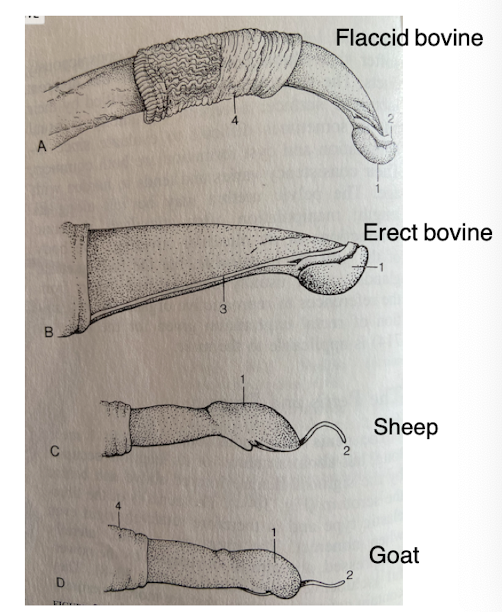
What species differences influence obstruction
Sheep/goats have the narrow urethral process.
Bovine penis shows differences when flaccid vs erect.
Overall, small ruminants have narrower lumens → higher obstruction risk
What are the most common obstruction sites for uroliths?
Urethral process (sheep & goats – most common)
Sigmoid flexure
Distal urethra
Anywhere along the urethra if stone burden is heavy
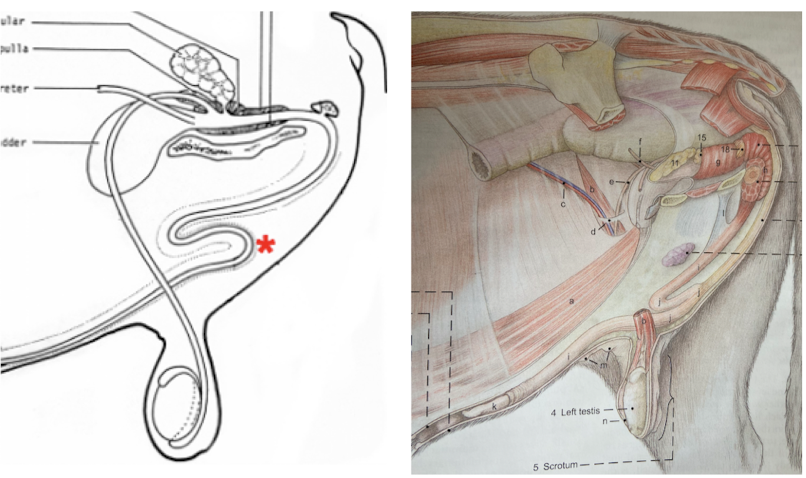
What are the presurgical anesthesia and restraint considerations in cattle?
Usually performed standing
Caudal epidural commonly used
Sedation only if absolutely necessary (risk of recumbency)
What anesthesia/restraint is used for sheep/goats?
Dorsal recumbency
Sedation or general anesthesia
Positioning critical for access
Why are economics and clinical status important presurgical factors?
Cost influences whether surgery is attempted (especially livestock)
Clinical status matters:
Obstruction present
Urethral rupture
Bladder rupture (worse prognosis)
How does intended animal use affect surgical decisions?
Feedlot steer: Just need urine outflow until slaughter
Breeding bull: Must preserve penis function + remove obstruction
Pet goat/sheep: Can consider temporary or permanent urine exit depending on recurrence or stone accessibility
What surgical options exist for obstructive urolithiasis?
Urethral process amputation
Perineal urethrotomy
Perineal urethrostomy (temporary or permanent)
Penile amputation
Tube cystotomy
+/- Bladder repair if ruptured
How is urethral process amputation performed?
Restrain sheep/goat on rump
Sedation + topical lidocaine
Exteriorize penis (can be challenging)
Cut urethral process with Mayo scissors
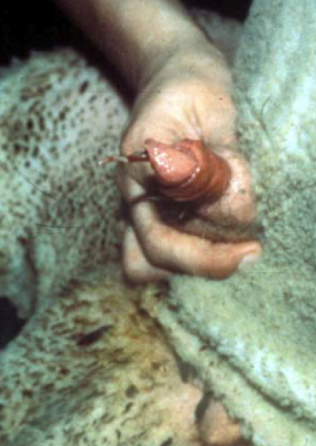
Why is urethral process amputation often done first?
Most common obstruction site
Quick and simple
Check for full urine stream afterward (stone may remain at sigmoid flexure)
Does not impact breeding ability in rams
What are the Perineal Urethrotomy/Urethrostomy surgical options?
High vs low approach
Temporary vs permanent urine exit
Technique chosen based on obstruction location & animal use
What defines high vs low PU approach?
High = at ischial arch
Low = caudal to scrotum
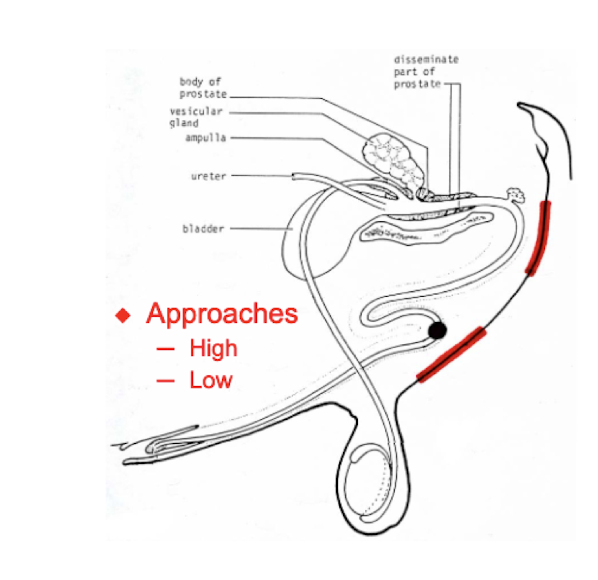
When is the low approach used for Perineal Urethrotomy/Urethrostomy?
To perform urethrotomy to remove calculi
To perform urethrostomy + penile amputation for permanent urine exit
What are advantages of the low approach for Perineal Urethrotomy/Urethrostomy?
Superficial penis → easier to exteriorize
Provides access to sigmoid flexure
Less skin irritation
Can be repeated
What are disadvantages of the low approach for Perineal Urethrotomy/Urethrostomy?
Awkward surgical position in standing cattle
Stones may lie more proximally (need ultrasound/rads/contrast beforehand)
When is the high approach used for Perineal Urethrotomy/Urethrostomy?
For permanent urethrostomy via penile amputation
What are key advantages of the high approach for Perineal Urethrotomy/Urethrostomy?
Position is proximal to almost all obstructions
Sheep/goats often accumulate stones proximal to sigmoid flexure → accessible here
What are disadvantages of the high approach for Perineal Urethrotomy/Urethrostomy?
Calculi often distal → may not be reachable
Penis deep and difficult to exteriorize
Higher risk of urine scalding (due to high urine outlet)
How do you choose between temporary and permanent PU?
Depends on surgical goals: preserve breeding function? Permanent urine exit? Stone removal? Animal value?
What are the purposes of temporary PU?
Low approach over sigmoid flexure
Provides temporary urine exit (heals by 2nd intention)
Can remove calculi then suture closed
Preserves penis function in breeding bull
What are disadvantages of temporary PU?
Stricture formation, especially in sheep/goats
Technically challenging
Why perform penile amputation during permanent PU?
Easier exteriorization
Easier urethral anchoring
Distal penis is often nonfunctional due to obstruction or rupture
What approaches can be used for permanent PU?
High or low approach (low preferred)
Used for obstruction ± urethral rupture
Provides permanent urine exit
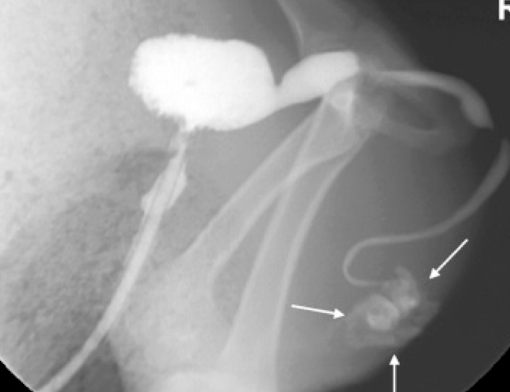
What are the steps for permanent PU surgery?
Dissect and exteriorize penis adequately
Ligate dorsal penile vessels (proximal & distal “stick tie”)
Amputate penis proximal to rupture/stone
Spatulate urethra
Suture urethral mucosa to skin edges for best results

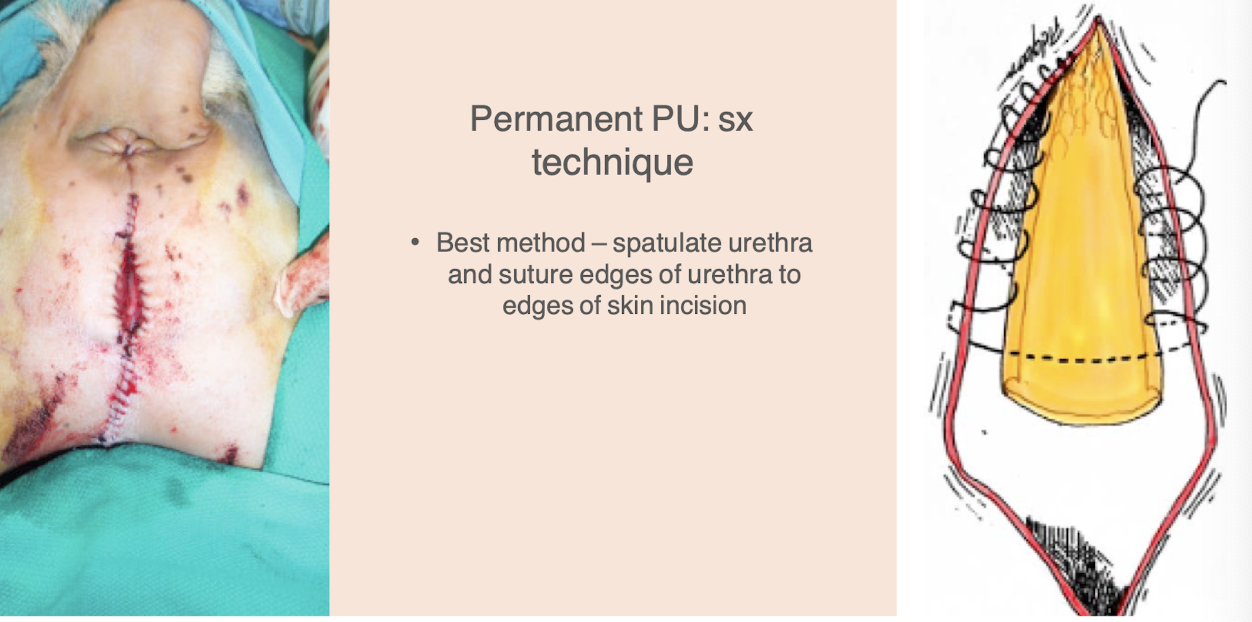
What makes retrograde catheterization difficult in these species?
Inability to exteriorize penis
Sigmoid flexure
Urethral diverticulum (especially in cattle)
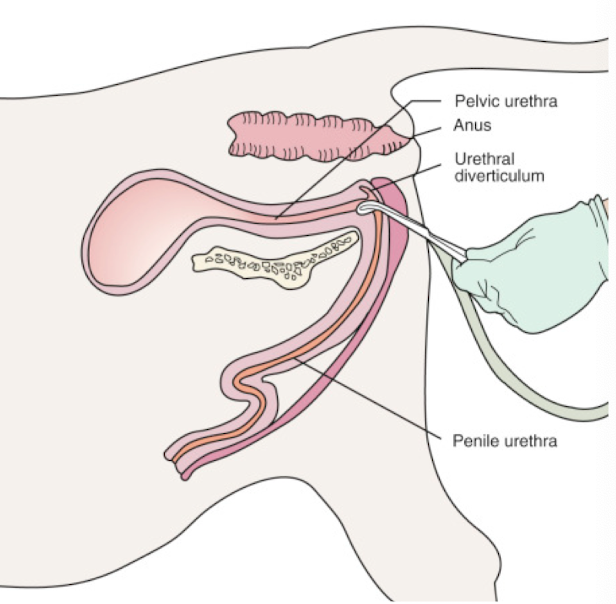
When is tube cystotomy used?
Sheep/goats with obstruction not relieved by urethral process amputation
Especially pets or valuable breeding animals
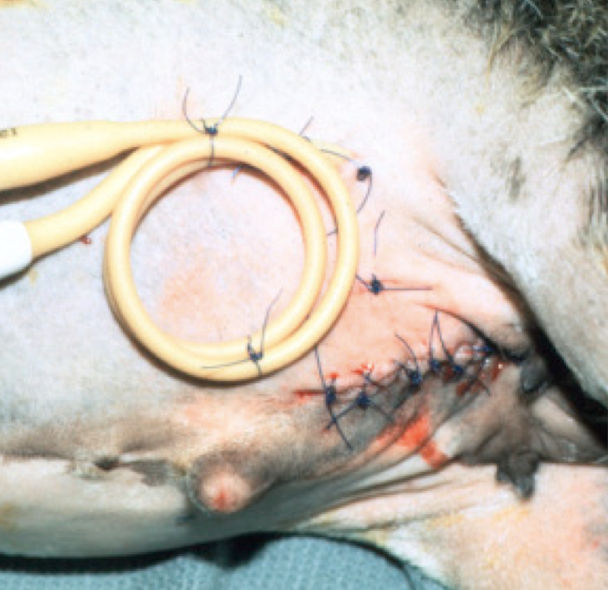
What is done in tube cystotomy?
Catheter placed via paramedian laparotomy & cystotomy
Provides temporary urine drainage
Allows prolonged medical dissolution of stones
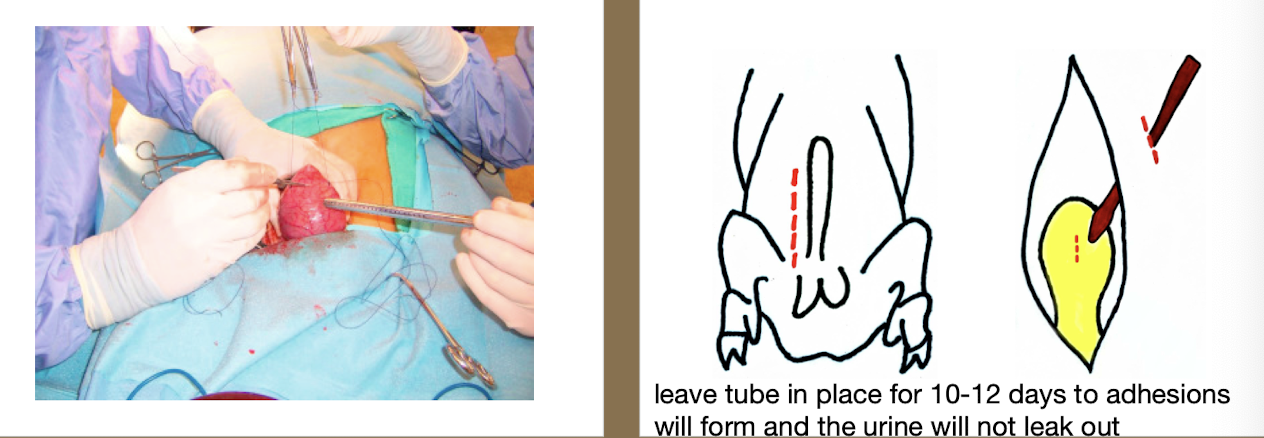
How are bladder ruptures managed in livestock?
Ideally surgically repaired → caudal paramedian inscision indwelling urinary catheter → aids healing then decompressed via catheter
BUT rarely performed in cattle/goats/sheep due to economics
More likely in pets or valuable breeders
What are the key postoperative treatments?
Systemic antibiotics (if indicated)
NSAIDs for analgesia/anti-inflammatory effect
Tetanus prophylaxis
Medical therapy to:
Treat remaining calculi
Prevent new calculi formation